To the question of a new typology of cultures: lukofily and lukofoby (part two)
(Psalm of 17: 15)
Of course, the knights were aware of the power of the bow. There were projects to prohibit the use of bow and crossbow on the battlefield. In 1215, crossbowmen, along with mercenary warriors and surgeons, were recognized as the “bloodiest” warriors. These bans did not have a practical impact on the use of archers in battle, but prejudice was born in the minds of the professional military elite - the bow is not suitable weapons to protect honor.
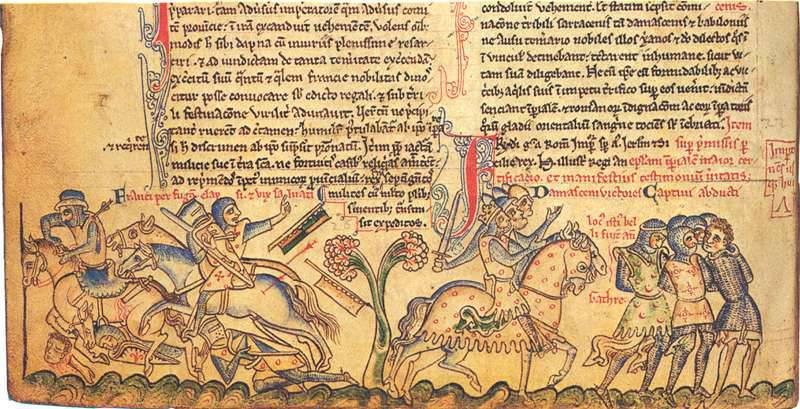
Battle of Beit Khanum. From the “Big Chronicle” by Matthew of Paris. Around 1240 - 1253 (Parker Library, College of "Body of Christ", Cambridge). Retreating under the arrows of the eastern archers and captive knights of the crusaders - this is the best evidence of the effectiveness of eastern bow!
Fortunately, the bulk of the Western knights in their countless wars dealt with opponents armed just like them. But for those who fought in Palestine, such a knightly prejudice was of fundamental importance. Starting from the 12th century, in the Holy Land and throughout the Mediterranean, they begin to hire Saracen archers, such mercenaries were called turcopols, and Frederick II used them many times in Italian campaigns. In the Mediterranean, the skillful skills of archers and crossbowmen took shape in the Late Middle Ages, so that archers became the main contingent in most Western armies.

Archers on the thumbnail of the "Maciejowski Bible." Pierpont Morgan Library.
However, they did not shoot from the saddle. They dismounted as soon as they arrived on the battlefield. Their horses provided mobility during the march and gave them the opportunity to pursue a fleeing enemy, but no one expected them to mount archery, that is, infidel tactics. Therefore, despite the hiring of Saracen archers, one can see that the general prejudice of the knight’s class against horse shooting dictated tactics even to socially lower strata who, of course, were not put in such difficult conditions. Due to the lack of interest that the knights showed in bows, the skill of horse shooting in the West never reached such heights as in the East. It also deprived the Western armies of the tactics of hitting heavy horse archers, warriors dressed in armor and using first a bow, and then a spear and a sword.
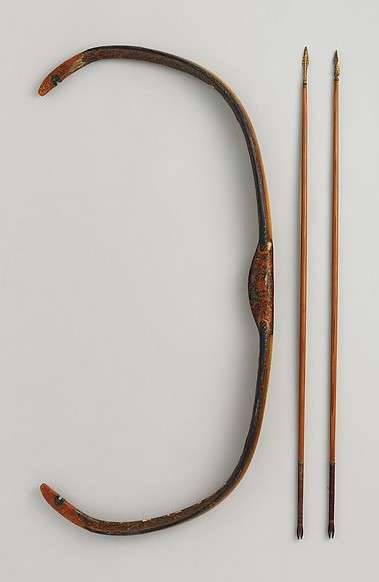
Mongolian bow and arrows. When not in use the bow is bent in the opposite direction. Metropolitan Museum, New York.
Only a few exceptions to this rule only reinforced the view that for a professional equestrian warrior, especially belonging to the knightly class, it is baseless to wear a bow. In the VI. the chronicle of the Franks Gregory of Tours mentions Count Ludasta, who wore a quiver over the chain mail. On all other grounds, the count was a member of the military elite of the Franks: he had a helmet, armor and, no doubt, he rode a horse. But he also wore a bow. This item may have been added to show that it was “parvenue”. He quickly rose from the cook and the stableman to the count and therefore did not have the decency of a true noble warrior. He was accused by the historian of spreading rumors that the queen had an intrigue with the bishop.
Stone arrowhead. The era of the late Paleolithic.
In the Middle Ages, knights with a bow were a literary and artistic device, symbolizing cowardice and ignorance, outside of any real connection with what is happening.
Siege of Avignon. Miniature from "The Chronicle of Saint-Denis." Around 1332 -1350 (British Library). Artist Cambrae Missal. Attention is drawn to the great similarity of this miniature to Assyrian reliefs, where the frequent plot is the siege of the fortress and the archers who bombard it.
In a letter to Abbot Furland, the emperor Charlemagne advised him to support his army with horsemen equipped with a shield, spear, sword, dagger and bow and arrows. Such a precedent did not convince anyone, and this was considered part of the general revival of Roman culture promoted by the retinue of Charlemagne. The following proof that the Carolingians had horse archers, is the illustration in the Golden Psalter of the 9th century. In one of her miniatures among a detachment of horsemen-spearmen army of the Carolingian army that attacked the city, one heavily armed soldier is shown in a typical mail shirt, wearing a helmet and a bow in his hands. But on the battlefield, judging by the late medieval manuscripts, cavalry archery for noble warriors becomes possible only if they participate in the hunt. In the psalter of Queen Mary, kept in the British Museum, there is a detail showing the king shooting at a grotesque creature from the back of a horse. It is possible that such a horse shooting in such a case was suitable. It was a world separated from the battle, as it was not the people who were killed, but the animals. But it is possible that both of these details were based on figures from oriental manuscripts used as a curious artistic trick.
The final origin of the noble Germanic prejudice can be traced to the Celtic art of horse shooting. This was the influence of the Greek battlefield. In a play written by Euripides in the 5th century BC, one of the heroes defamed Hercules ’valor:“ He never wore a shield or spear. He used a bow, a coward's weapon - to strike and run. Luke does not make heroes. A real man is the only one who is firm in spirit and dares to stand against the spear. ” Hercules' father says in his defense: “A man skilled in archery can send a hail of arrows and keep something else in reserve. He can keep his distance so that the enemy never sees him, only his arrows. He is never substituted to the enemy. This is the first rule of war - to harm the enemy, and as much as possible, while remaining unscathed by himself. " That is, such an opinion existed among the Greeks already then, and they also belonged to the people of lukofobami. The Romans also considered the bow to be a cunning and childish weapon and did not use it themselves, but hired (by necessity) detachments of archers in the East.
Tim Newark quotes Xenophon as saying that "for inflicting the greatest harm to the enemy, the saber (the famous Greek masterpiece) is better than the sword, because using the rider's position to deliver a chopping blow to the Persian saber is more effective than with the sword." Instead of a spear with a long shaft, which is inconvenient to handle, Xenophon recommended two Persian darts. A warrior armed with them can hurl one dart and use another in close combat. “We recommend,” he wrote, “to throw the dart as far as possible. This gives the warrior more time to turn the horse around and grab another dart. ”
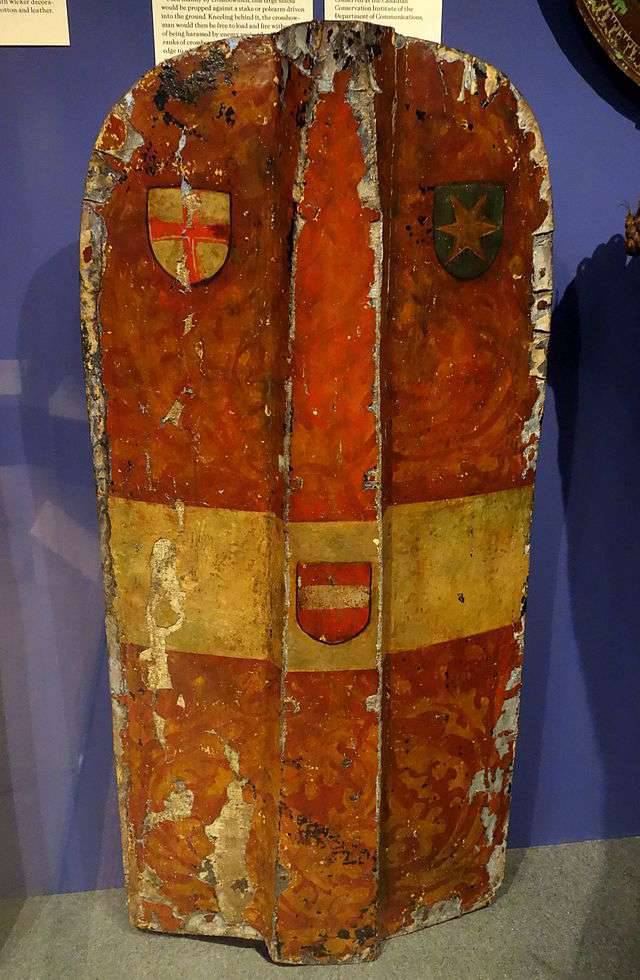
European paveza arbaletchika XV century. from the Glenbow Museum.
Throwing darts becomes a characteristic battle tactic for all pre-Christian western cavalry warriors, including the early Romans, Celts and Germans. In early medieval Europe, equestrian warriors who throw spears, we meet up to the battle of Hastings. A tapestry from Bayeux shows several Norman knights throwing their spears at the Anglo-Saxons, while the rest left their spears for close combat. The archers on the tapestry are practically all infantrymen and, in addition, are depicted on the hem, that is, outside the main field.
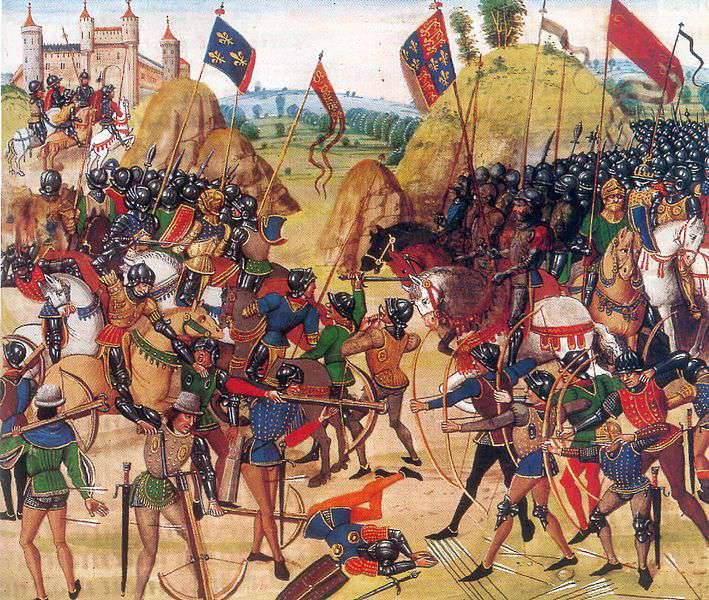
Battle of Crecy. The famous miniature from the Chronicle of Jean Froissart. (National Library of France)
The emergence of stirrups in Western Europe was a turning point in stories cavalry But the stirrup at first did not change the course of equestrian combat. The transition from javelin throwing to owning them took centuries, and in this a prejudice about the new, again, rather than the introduction of the stirrup, played a big role. Even when other types of long-range missile weapons were invented, prejudice against the bow as against “the most cruel and cowardly weapon” continued to exist, which is why the knights and noble warriors refused to use it. Such was the influence of this purely aristocratic prejudice, born of German military democracy in ancient times. He determined the nature of warfare for a whole thousand years - the most remarkable case of social fraud, outweighing any military logic, says T. Newark [3].
Barbut - helmet crossbowmen and archers 1470 Brescia. Weight 2,21 kg. Metropolitan Museum, New York
The validity of these views of the English historian seems quite obvious, especially in comparison with the combat technique and the nature of defensive weapons among the peoples of the East, where excessively heavy all-metal armor never existed because the main weapon of the battle throughout the Middle Ages was the bow. This is particularly evident in the example of samurai and ashigaru in Japan, which Stephen Turnbull constantly writes about, and where the concepts of “archery” and “fight” have always been the same!

Hugh de Bob flees from the battlefield of Bouvin (1214). "Great Chronicle" Matthew Paris., Approx. 1250 (Parker Library, Body of Christ College, Cambridge). It is believed that this is an evil satire on this cowardly knight. After all, none of the characters depicted in this miniature has a quiver of arrows!
The British historian D. Nicole, who also paid a lot of attention to this issue, wrote about the coincidence in the battle tactics of the Mongols and riders of the 13th century Baltic peoples, who used darts for throwing on a gallop. Attacking, throwing an enemy with darts and immediately pretending to retreat are the attack methods of the Estonians, Lithuanians and Balts, which is why they used the saddle of the corresponding sample [4].
So, it is precisely in the field of the use of strike and throwing weapons that “watershed” lies, which today, according to most British historians, determines the nature of the development of protective weapons in the whole of Eurasia.
The works of English-speaking researchers confirm the fact that it was the lamellar armor that was the most ancient and widespread. But the chain mail - and in this they align themselves with the judgment of the Italian historian F. Cardini, is the result of the development of the ritual vestments of ancient shamans, magicians and sorcerers who sew metal rings on their clothes to protect them from evil spirits and intertwine them. ring protection. Subsequently, the warriors who fought on horseback and do not use bows and arrows, appreciated its flexibility, which made the chain mail comfortable to wear, while the horse archers (and first of all the nomads) needed to think about how to defend themselves from arrows launched from powerful onions from a distance. Where, how and why this separation took place, the historical point of the above “watershed” itself is unknown to us today, but this does not mean that it does not indicate the object of the search for ancient artifacts. Perhaps it will be the finds of cult burials with a large number of metal rings, both connected to each other and sewn in rows on the skin. If there are bone or stone arrowheads in the same burials, which, however, can be considered exceptional success, the conclusion will be obvious that such protection was very reliable at that time, and this could give rise to confidence in the extremely high protective capabilities of chain mail . The plates sewn on leather or fabric base were more accessible, common, one might even say, “traditional.” Because of this, they were used exactly where they were really needed, then, as the chain mail personified not only physical, but also magical protection, even in the Middle Ages, this was no longer remembered.
Absolutely unique miniature, and one of a kind (!), Which depicts a knight, shooting from a bow from a horse, and having at the same time a quiver. That is, it is really a horse archer, which is absolutely atypical for a Western European knight! What made him do this and, most importantly, why this was reflected in this miniature, is unknown. Interestingly, this miniature also belongs to the 1298 Chronicle of Colmariens (British Library). That is, the sea battle, and this knight painted the same artist. And how to know what he had on his mind? After all, in other manuscripts on miniatures of other artists, including the same time, we will not see anything like this. That is, it belongs to the category of single sources!
Actually knightly armor lasted the longest time precisely where the development of society was slow compared to the rapid progress of market relations in Europe. For example, in North Africa and in Tibet, where armor was worn even in 1936. So, in the Caucasus, we have steel helmets, elbow pads, chain mail and shields — that is, The “white” and noble weapon was used by the Imperial Convoy of the Russian Tsar from the mountain peoples right up to the middle of the XIX century, that is, almost as long as in Japan.
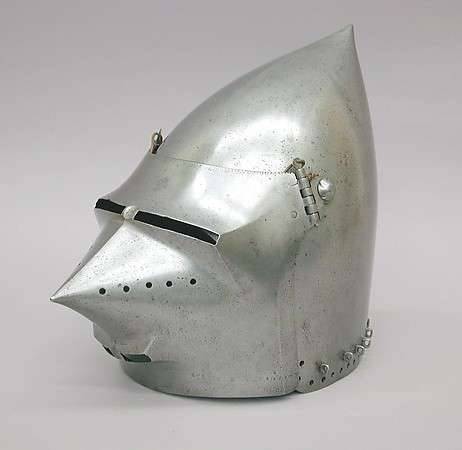
French bascinet 1410. Weight 2891,2 Metropolitan Museum, New York.
It can be concluded that this typology, based on the division of cultures on the basis of recognizing the bow as a worthy weapon, also has the right to be present among numerous cultural typologies, and its use allows you to take a fresh look at many phenomena in the culture of past centuries. After all, the same hatred of the western knights for their eastern opponents, practically in the same knightly armament, was, as we see, based not only on differences in faith. Eastern horsemen, who did not see anything shameful in using a bow against their peers, looked in the eyes of Western knights also immoral people who violated the customs of knight war and therefore unworthy of their knightly attitude! Even greater hatred, however, was deserved in their eyes by those who were not directly "warriors of the East", but used bows and arrows along with ordinary knightly weapons, that is, they borrowed the very best both here and there, and, therefore, were higher traditional chivalrous prejudices. So, it would seem that from this purely technical aspect there is also a difference in the forms of thinking, which is also of fundamental importance for improving the typology of cultures in all their specific diversity.
1. Jaspers K. The origins of history and its purpose // Jaspers K. The meaning and purpose of history, 1991. P.53.
2. Shpakovsky V.O. History of knightly weapons. M., Lomonosov, 2013. P.8.
3. Newark T. Why knights never used bows (Horse Archery in Western Europe)//Military illustrated. 1995. No. 81, February. PR. 36-39.
4. Nicolle D. Raiders of the Ice War. Medieval Warfare Teutonic Knights ambush Lithuanian Raiders//Military illustrated. Vol. 94 March. 1996. P.R. 26-29.
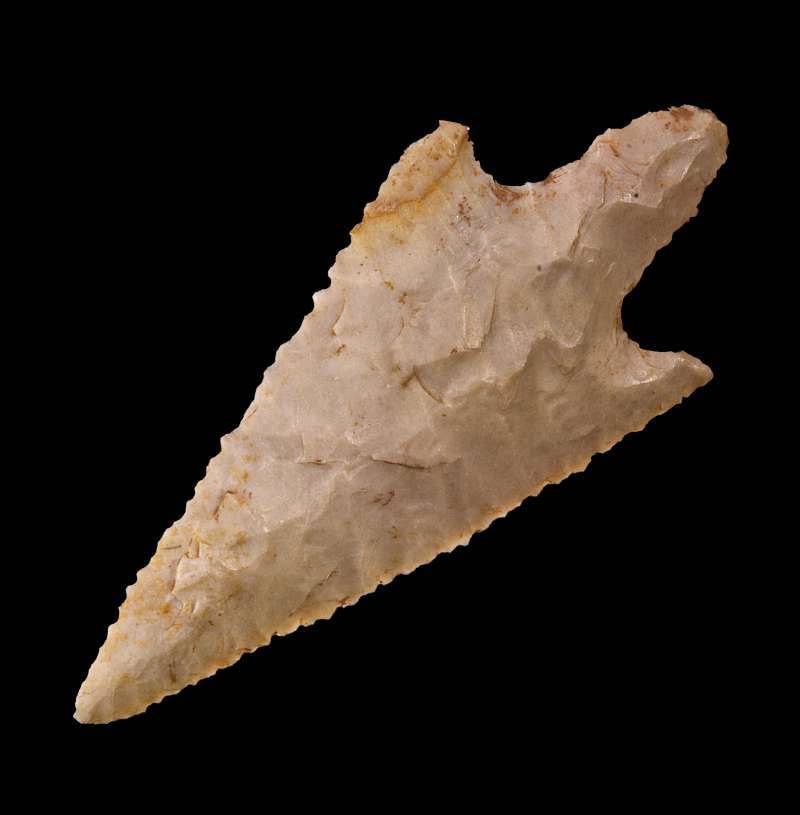
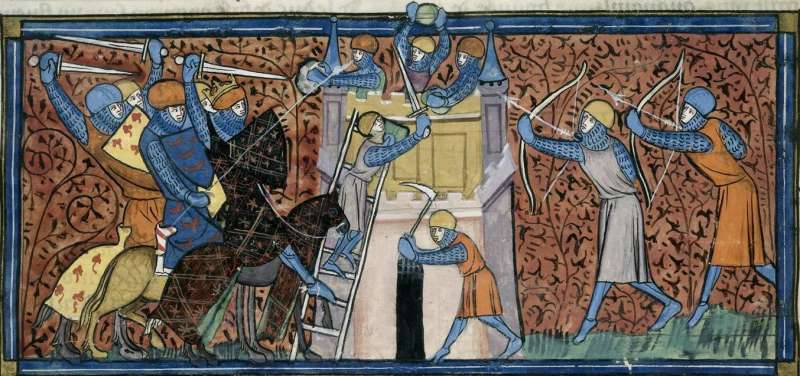
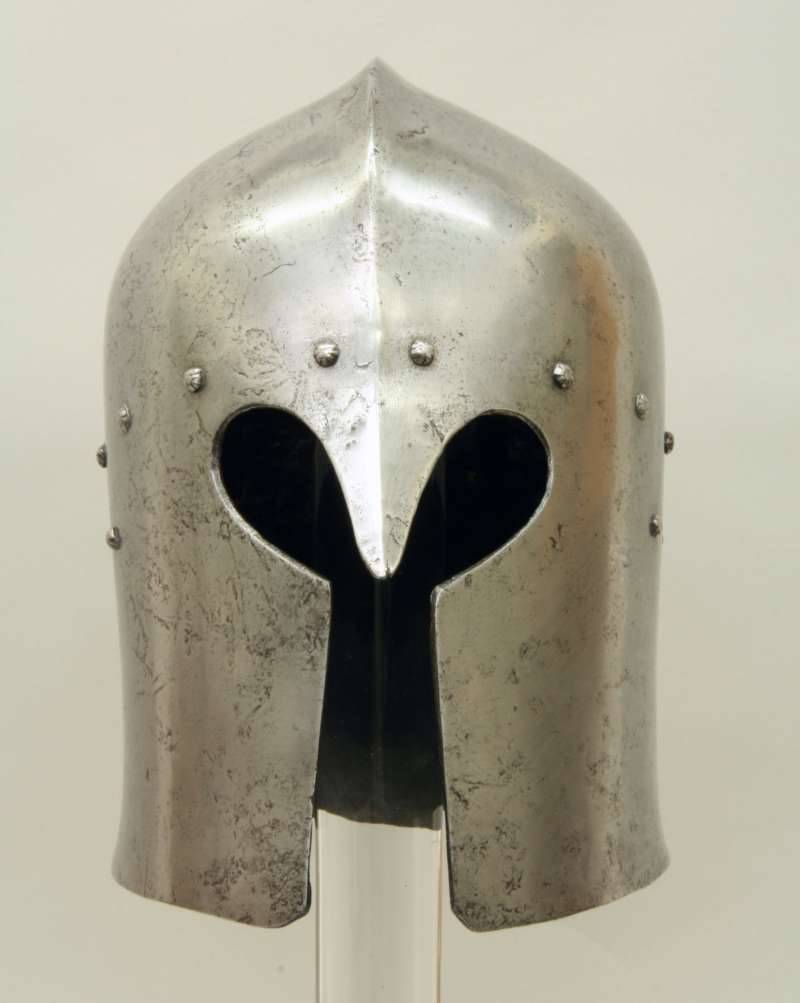
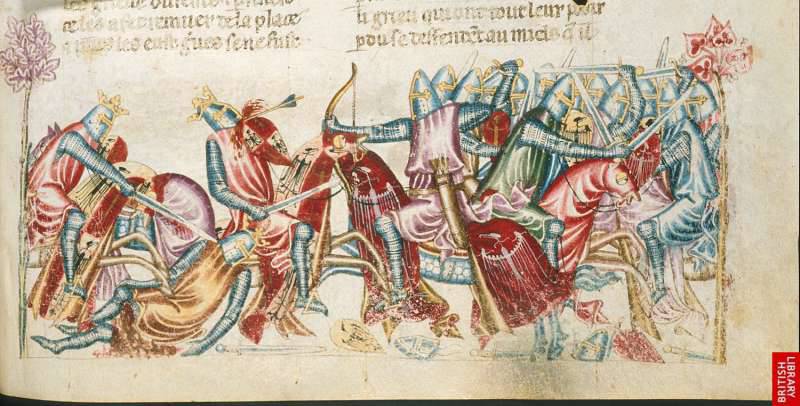
Information